#little black cormorants
Text
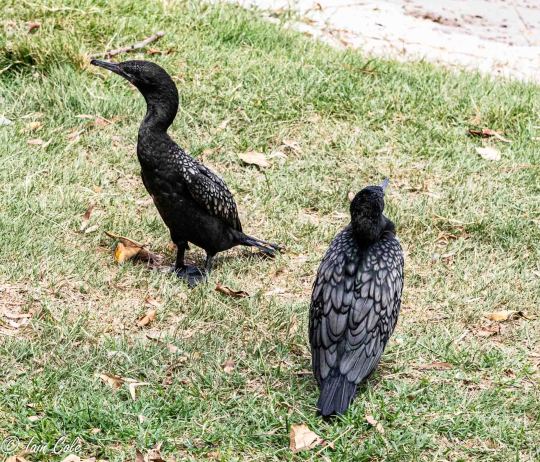

Giving the Ravens a run for their money
Little Black Cormorants
#original photographers#nature photography#wildlife photography#bird photography#Little Black Cormorants#Noosa River
69 notes
·
View notes
Text

little black cormorants....look at those big blue eyebals


#birds#birding#ornithology#special interest#bird#bird photography#birdblr#australian birds#little black cormorant#cormorant#phalacrocoracidae
20 notes
·
View notes
Text
Idk what you’d call it but maladaptive daydreaming or whatever takes up so much of my time and it’s so hard to get myself to sit down and read/watch something even if I really really like it :(
#I genuinely love Black Sails so far!! and the first Baru Cormorant book!! and ORV!!#but just getting myself to sit down and start watching initially is so hard#I can get myself to sit and knit and listen to an audiobook or make an AMV or something#because that’s not as passive#I don’t like only being able to read through audiobooks bc I miss little details and I have to rewind so often#plus not everything I want to read comes in audiobook form#I spend like 90% of my time just pacing around listening to the same songs again and again#and medication has significantly increased my ability to get myself to do things but focusing on reading or watching something is still so#hard#personal
7 notes
·
View notes
Text
huge respect to @myxinidaes for reblogging that post with 100 birds
#ok im gonna try to list 100 birds. house sparrow song sparrow fox sparrow white-throated sparrow dark-eyed junco#robin. ovenbird. hermit thrush. carolina wren. cardinal#carolina chickadee. house finch. purple finch. goldfinch. white-breasted nuthatch#red-breasted nuthatch. hooded merganser. american coot. wood duck. mallard duck#surf scoter. ruddy duck. black duck. northern shoveler. common loon#crow. fish crow. raven. turkey vulture. bald eagle#feral pigeon. mourning dove. turkey. quail. AMERICAN WOODCOCK#solitary sandpiper. herring gull. great black-backed gull. piping plover. killdeer#yellow-rumped warbler. pine warbler. palm warbler. black and white warbler. i cant think of a fifth warbler. red tailed hawk#cooper's hawk. osprey. barn swallow. tree swallow. blue jay#peacock. egyptian goose. peregrine falcon. merlin. canadian goose#green heron. starting to struggle here. flamingo. skua. albatross. great blue heron#barn owl - snowy owl - great horned owl - barred owl - WHAT was that little owl in central park called - uhhh mandarin duck#chicken. california condor. rose finch (there are many but i dont remember any of the weirder species). adelie penguin. emperor penguin#northern mockingbird.. starling.. grackle.. african gray parrot.. monk parakeet#stellar's jay ... baltimore oriole.. argh what's the other oriole we get. DOWNY WOODPECKER.. hairy woodpecker... pileated woodpecker#red-headed woodpecker. red-bellied woodpecker. ruby-throated hummingbird. scarlet macaw. whooping crane#whippoorwill. snowy egret. great egret. european robin. bird of paradise#there's a warbler that's just 'yellow' right? yellow warbler? cormorant...#struggling with some where i cant remember the exact name like was it a 'double crested' cormorant or something else.#zebra finch .. blue-footed booby... pelican....#australian magpie. The Other Magpie. ibis (nonspecific). potoo. EASTERN BLUEBIRDDDDDD !!!#ceruleanrambling#now i can go read yours
17 notes
·
View notes
Photo


Royal Botanic Gardens, Sydney
April 2023
7 notes
·
View notes
Text
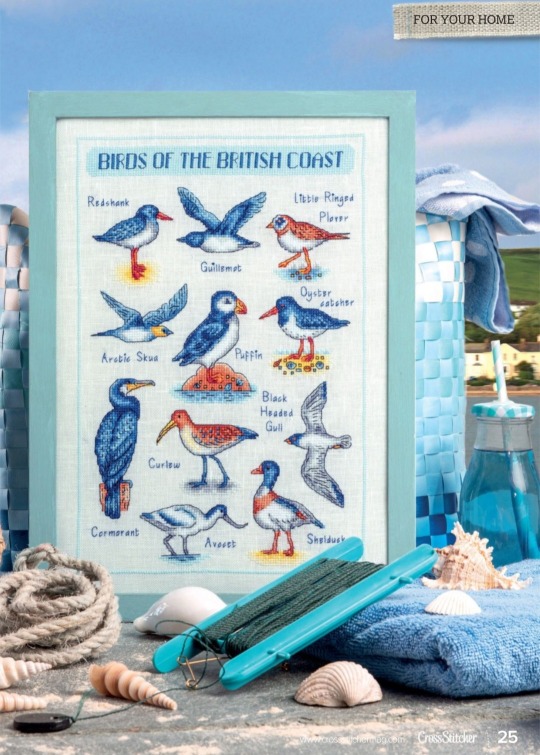

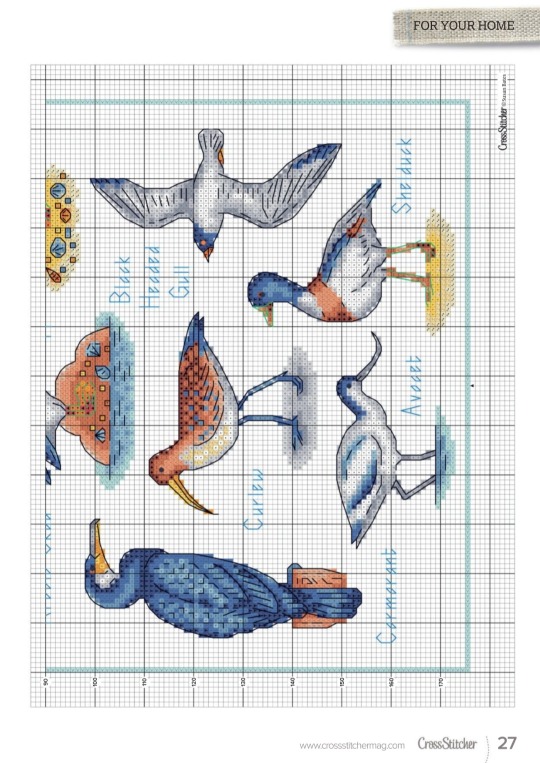

#cross stitch#cross stitch pattern#british birds#cormorant#shelduck#avocet#black headed gull#curlew#oyster catcher#little ringed plover#guillemot#puffin#redshank#arctic skua
11 notes
·
View notes
Photo
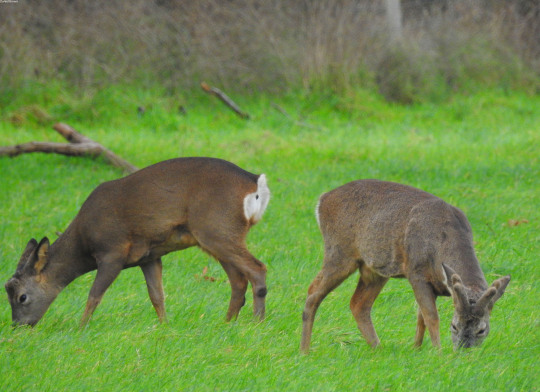
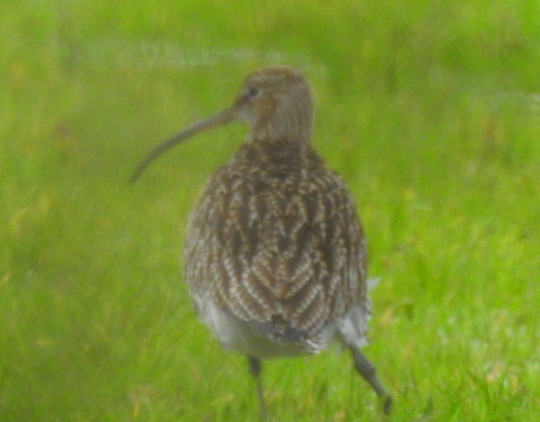





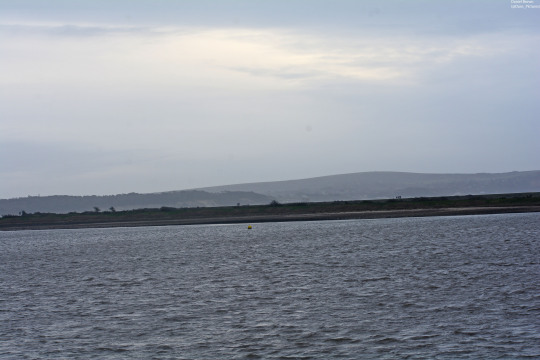
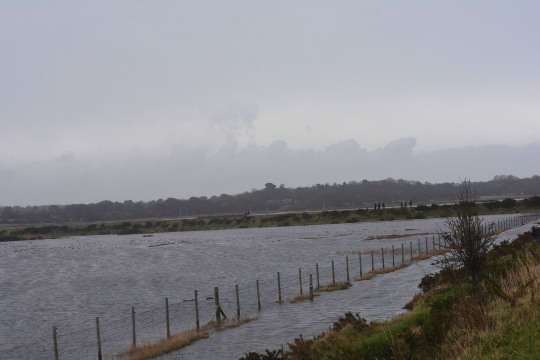

01/01/2023-Blog 2 of 2: Lymington
Following on from my previous post, we then today went to Lymington and added some useful variety of birds of the coast and marsh to see another amazing amount of birds on a New Year’s Day which feels fantastic. I got 28 more year ticks at Lymington and on the way there from the car taking my year list to 57 making it my second highest ever New Year’s Day total after 2021 just three birds behind it which is amazing. To get so close to the 2021 amount of species seen after one day is great another year where I combined Lakeside and a coastal marsh reserve to cover so many bases for types of species seen.
This afternoon it was good to see lots of ducks and waders for the first time this year on and near to Normandy lagoon including elegant Pintail, Avocet, Lapwing, beautiful Grey Plover and two serene Greenshank with one dashing past a Pintail, Lapwing and Wigeon all lined up on the lagoon early in the walk which was an enchanting sight. We got some splendid views of two Curlews by a puddle in a field at the start of the walk I took the second picture in this photoset of one, a captivating rustic sight. We saw gigantic Great Black-backed Gulls well here today another year tick. History repeated itself not for the first time after last year today when we caught sight quickly of a pleasing early first Bullfinch of the year for us we saw one here on 2nd January last year always a good one to get seen in a year. Brent Geese, Shelducks, Little Egret and Great Crested Grebe were four more of my favourite birds to see for the first time this year after the two woodpeckers at Lakeside this morning and my first Buzzards of the year from the motorway on the way here one from the usual spot I’ve been seeing one a lot lately and another flying soon after. It was also a delight to see a few dainty Little Grebes at Lymington today.
A third grebe species and one more favourite bird of mine grabbed the headlines of the trip to this special reserve. Firstly it was a real treat to see a handsome and thrilling Slavonian Grebe in the inlet between the shore by Normandy lagoon and the first mudflat with the tide in. A bird we have seen on this bit before, a specialty of this reserve at this time of year that is one of our highest calibre species seen of this young year, for a species I memorably saw for the first time of 2019 here on Christmas Day it’s the first time I’ve ever seen one on a New Year’s Day the sort of thing I was hoping for as whilst we’ve come here early in the New Year before we never had on January 1st and it must be the quickest I’ve ever reached three grebe species seen in a year. The other favourite bird was an angelic Kingfisher settling on a post before flashing across the lagoon, an honour to see for a species that has starred on New Year’s Day and at the start of the year before for me. Another stunning Goldcrest seen well today at the start was a highlight of the walk too.
There were lovely mammal moments with three Roe Deers seen in fields at the start where I had seen them early in a year before I took the first picture in this photoset of two and New Forest ponies seen on the way and including an adorable smaller one which the fourth picture in this photoset shows in the field at the start of the walk. Cleavers, bramble, I seem to recall teasel seed heads and in flower gorse were plant highlights here this afternoon. It was nice to see mistletoe on journeys today. There were beautiful moody coastal views here today with rain coming on as the walk went on and it was interesting to see excess water here too. There were pretty cloud scenes out here this afternoon. I took the third, fifth, sixth, seventh, eighth, ninth and tenth pictures in this photoset of views here today. A special start to the year, I hope you’ve all had a good day and have a good week.
Wildlife Sightings Summary for Lymington: My first of five of my favourite birds the Shelduck, Brent Goose, Little Egret, Great Crested Grebe and Kingfisher this year, my first of one of my favourite mammals the Roe Deer of the year, my first Curlew, Great Black-backed Gull, Canada Goose, Shoveler, Teal, Cormorant, Bullfinch, Pintail, Lapwing, Wigeon, Greenshank, Avocet, Redshank, Tufted Duck, Grey Heron, Little Grebe, Turnstone, Dunlin, Slavonian Grebe, Oystercatcher, Stonechat and Grey Plover of the year, Carrion Crow, Goldcrest, Starling, Mallard, Herring Gull and Black-headed Gull. I also heard another of my favourite birds the Green Woodpecker.
#lymington#shelduck#brent goose#brent geese#shelducks#little egret#great crested grebe#kingfisher#roe deer#roe deers#curlew#great black-backed gull#canada goose#shoveler#teal#cormorant#bullfinch#pintail#lapwing#wigeon#greenshank#avocet#redshank#tufted duck#grey heron#little grebe#turnstone#dunlin#slavonian grebe#oystercatcher
5 notes
·
View notes
Text

momray
Don’t you just love it when your transphobic dickass aunt gets killed by her daughter/disease/other unforeseen circumstances and your the only heir because the only other heir old enough/not the murderer is away teaching kids on a different continent and then you also have to take care of her kids who are basically toddlers
Quick guide to the little guys seen here. Auklet is the blue-green one with white and orange markings on her head. Storm is white-grey one on her scarf. Petrel is the blue one with red markings in her armpit. The orange, black, and red wing ornament is Cormorant.

#her design is inspired by green and dragon moray eels and few species of shark#my art#procreate#digital art#wof#wings of fire#dragon#wof headcanon#wof AU#2024#wof moray#wof seawing#wof auklet#also yes this is what the previous text post was about#transgender#fanart
402 notes
·
View notes
Text
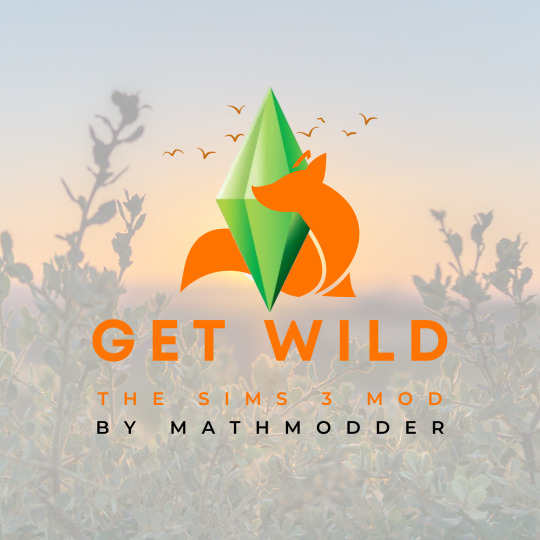
youtube
Get Wild Mod by MathModder (In Progress)
What you need to know:
This mod introduces wild animals into your game map that spawn naturally in beetle spawners. It includes birds, small mammals, amphibians, more insects and reptiles in nature zones. Birds can fly and land in random locations and ground animals can be seen walking around the map.
You can choose ONE from various versions that best suit your world. Select the version that spawns specific animals suitable for your World's location.
Here's a list of potential versions that will be included in the mod:
All Wildlife (City World)*
All Wildlife (Medieval / Country town)**
American Wildlife (City World)*
American Wildlife (Medieval / Country town)**
European Wildlife (City World)*
European Wildlife (Medieval / Country town)**
African Wildlife (City World)*
African Wildlife (Medieval / Country town)**
Eastern Wildlife (City World)*
Eastern Wildlife (Medieval / Country town)**
*Versions for cities will have additional specific effects that help create a more beautiful environment for your city, such as planes in the sky, fireworks, sunshine rays during the day, and sky lanterns for the All Wildlife and Eastern Wildlife version.
**Versions for Medieval/Country towns will feature additional specific effects to enhance the beauty of your world, including hot air balloons in the sky, sunshine rays during the day, and more.
These additional effects mentioned above will appear rarely and randomly in your world.
Can I place individual animals in specific locations, such as on rocks or tables?
In a future update after launch, this function will be added, for now they will only spawn where there is a beetle spawner. Ground animals on the ground and birds in the air.
Is the mod heavy to run?
Within the game I am optimizing it so that a small number of animals spawn at the same time and only spawn at a maximum distance of 500 meters from the player's camera.
How many files will there be?
Because there are many animals and specific animations for each one, the files will be heavy, will be a maximum of 2 to 3 files. In tests in my game with 150 other mods from other creators, I didn't see any loss of performance due to the optimization I'm doing within the game.
It is worth mentioning that some files will need to be placed in the Overrides folder and others in the Packages folder, they will all be specified at launch.
Is this mod compatible with other effect mods?
Yes, it will be compatible.
Bugs:
Depending on the location, there may be some bugs such as birds landing in the air or animals walking a little above the ground, this is due to calculation problems on certain game surfaces and physics, whether hills or mountains, but over time I will update and see What can I do to reduce this. In this case I depend on the engine the game has and whether it is possible to correct certain errors.
Release date:
Between January and February 2024 (It is in the testing phase)
Here is the list of animals that will be included in the mod:
American Eagle Bird
Anteater
Artic Tern
Aphids
Bat
Beaver
Bees
Black Bird
Black Egret
Black Fox
Black Goose
Black Rat
Blue Bird
Blue Frog
Blue Green Parrot Bird
Blue Jay
Blue Lizard
Blue Parakeet
Blue Macaw
Booby Bird
Brown Bird
Brown Bunny
Brown Egret
Brown Hen
Brown Monkey
Brown Owl Bird
Brown Pelican Bird
Brown Squirrel
Bullfinch Bird
Bullfrog
Butterflies (many colors)
Buzzard Bird
Canary
Capercaillie Female Bird
Capercaillie Male Bird
Canadian Goose
Cardinal
Carcara Bird
Charadriidae
Chimp
Chimpmunk
Chukar partridge
Condor Bird
Cormorant
Coyote
Crow
Cicada
Cockroach
Dart Frog
Dove Bird
Dragonfly
Egret
European Goldfinch
Falcon
Female Peacock Bird
Flamingo Bird
Fox
Fireflies
Golden Monkey
Golden Pheasant
Goldfinch
Gray Frog
Gray Lizard
Gray Parrot Bird
Gray Partridge
Green Bird
Green Frog
Green Lizard
Green Parakeet
Green Parrot Bird
Harlequin Duck
Hawk
Heron Bird
Hoopoe Bird
Horn Owl Bird
Humming Bird
Humming Bird Loop
Jack Rabbit
Kinkajou
Komodo Dragon
Ladybug
Lilac-breasted Roller
Little Red Parrot
Little Yellow Bird
Little Yellow Parrot
Magpie
Mallard Bird
Marmot
Marten
Male Peacock Bird
Mole
Multicolor Bird
Nude Rat
Orange Bird
Orange Fox
Orange Frog
Owl
Pangolin
Pheasant
Pink Cockatoo
Piper Bird
Possum
Pigeon
Quero-Quero Bird
Raccoon
Raven
Red-Eyed
Red Fox
Red Frog
Red Head White Cardeal
Red Lizard
Red Panda
Red Macaw
Red-crowned Crane
Rooster
Scissor White Bird
Sea Parrot Bird
Seagull
Silver Pigeon
Skunk
Snake
Sparrow
Spiny Lizard
Stork
Striped Lizard
Swallow Bird
Toco Toucan
Tortoise
Vulture Bird
White Bunny
White Cockatoo Bird
White Diving Bird
White Fox
White Goose
White Hen
White Monkey
White Owl
White Pelican Bird
White Piper Bird
White Rat
White Squirrel
White Swan
Wild Rabbit
Woodpecker
Yellow Lizard
Yellow Parakeet
Yellow Pelican Bird
Yellow Toucan
Want to support? Be a Patreon and get Early Access!
Math Modder | The Sims 3 Mods and MO-MO-MORE! | Patreon
If you have any questions, leave them in the comments and I will add them to this post!
428 notes
·
View notes
Text
Mem., get recipe for Mina: a food guide to Dracula Daily
Inspired by There and Snack Again (in which you eat along with the LOTR movies), this is your guide to eating and drinking along with Dracula Daily.
All under a cut because there's no way I can do this without extensive spoilers. I strongly recommend not reading this unless you already know what happens in Dracula. Also only if you're comfortable reading about alcoholic drinks - there's a lot of booze in this novel.
Let's eat!
2 May
We start with the famous paprika hendl. Google "chicken paprikash" and choose whichever recipe most strikes your fancy.

3 May
For breakfast, choose from mamaliga (cornmeal porridge, similar to grits), "impletata" (vânătă umplută - stuffed aubergine) or anything with more paprika in it.
4 May
For dinner, Jonathan has robber steak: "bits of bacon, onion, and beef, seasoned with red pepper, and strung on sticks and roasted over the fire".
5 May
Slivovitz, if you'd like it (Jonathan declines). Then, for dinner, Dracula serves up roast chicken, with some cheese, a salad and a glass or two of Tokaji wine.
6 May
"A cold breakfast" for Jonathan. In Romania a cold breakfast might include boiled eggs, telemea (sheep's cheese), franzela (bread) with assorted spreads, sliced cucumber and tomatoes, and sunculita taraneasca (sliced smoked pork). Jonathan also has "an excellent supper", but doesn't tell us what that includes.
16 May
Would it be too bleak if I suggested eating a symbolic Jelly Baby?
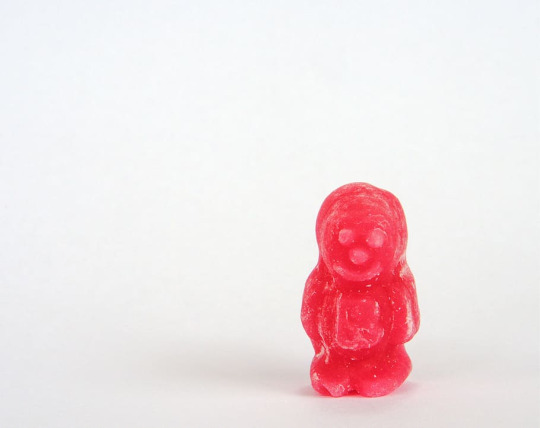
26 May
A glass of wine as Quincey and Jack congratulate Arthur and drown their sorrows.
18 June
There's a kind of Scottish fruit slice called "flies' graveyard". That might make a suitable snack given Renfield's meal today.
24 June
I guess a gingerbread woman, for the wolves? IDK, it turns out doing this for a horror novel is a bit grim.
8 July
Thankfully the internet has hundreds of ideas for spider-themed cakes so you can eat along with Renfield.
18 July
The voyage of the Demeter begins! Celebrate by eating like a sailor: have some salt pork, or make ship's biscuit.
20 July
Renfield has just eaten several sparrows. Provide redress by feeding birds near you, bird flu guidance permitting.

24 July
Imitate the "feet-folk" from York and Leeds by drinking some tea or eating some cured herring.
10 August
Lucy and Mina enjoy a "severe tea". There are lots of severe teas in Victorian literature, but few writers actually describe what's in it - e.g. the Churchman's shilling magazine, 1868, has a story with a severe tea "which implies coffee, tea, and muffins, with substantials". What are substantials? I have no idea, but that's what you should eat today.
11 August
Dracula has a little nibble on Lucy. I don't suggest doing this for every vampire bite in the novel, but given this one is particularly significant, how about marking the occasion with some black pudding?
30 August
No food details for a while, but in this entry, Lucy notes that she "has an appetite like a cormorant" and "Arthur says I am getting fat". Celebrate with some cake.
3 September
Van Helsing has been! And surely he wouldn't have come all the way from the Netherlands empty-handed? Acknowledge his visit with some gouda or a stroopwafel.
4 September
Eat some sugar, which Renfield has requested for his flies.
7 September
To stay in line with what the characters actually eat and drink, have a glass of port (though ideally not if you've just given blood). But for the real spirit of the day, consider a corn-on-the-cob.

9 September
Free space! Jack has "an excellent meal" but doesn't say what it is. Dig into your favourite dinner.
10 September
A sip of brandy, with which Van Helsing wets Lucy's lips.
11 September
The garlic flowers arrive. There's lots that you can make with wild garlic - personally, I like it in risotto.
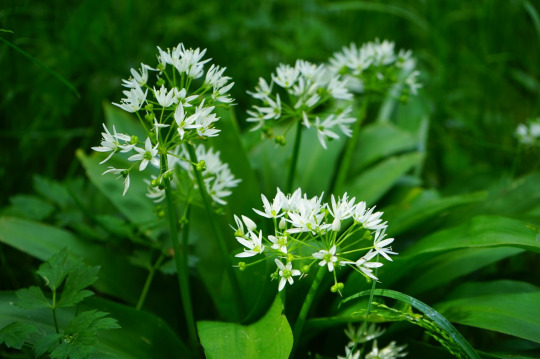
17 September
A boxful of garlic flowers arrive for Lucy every day. Time to make chicken with 40 cloves of garlic. Other options for today include more black pudding (in honour of Renfield lapping up Jack's blood) or sherry.
18 September
The Zookeeper enjoys a teacake, and so shall we.
20 September
No food, but the labourers have "a stiff glass of grog". This is rum diluted with water, but you could also add lemon or lime juice, sugar, and/or cinnamon.
25 September
Nibble another Jelly Baby for the Bloofer Lady.
29 September
A lot happens in this entry, but there's not a lot of food. There are thirsty labourers, however. Maybe have a beer?

30 September
Mina makes everyone a pot of tea. Also, we don't know what they have for dinner, but they eat it at 7pm, if you'd like to time your evening meal accordingly.
1 October
More tea! Since this is being gulped down by a working man, make it builder's style - strong, sweet, lots of milk.
2 October
Jonathan visits the Aërated Bread Company. He only has a cup of tea, but you could have whatever you like best from their menu:
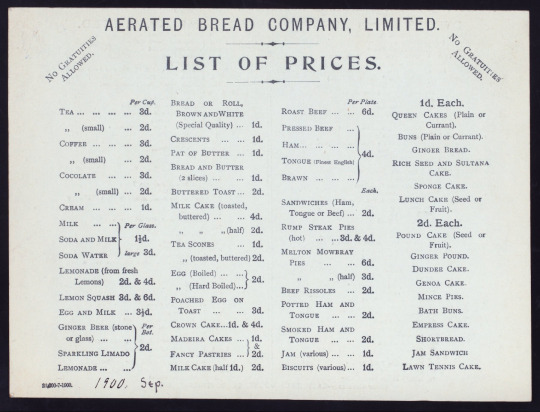
(source)
3 October
Dracula forces Mina to drink his blood like "a child forcing a kitten's nose into a saucer of milk". You could either have some more black pudding, or drink a glass of milk in solidarity with Mina.
15 October
The Crew of Light aren't focusing much on meals any more, but they have travelled on the Orient Express. Here's the 1887 dining car menu.

(source - I can't vouch for the accuracy of a random person on Twitter but it looks plausible)
29 October
No one is thinking of food in this bit of the novel (though Mina makes yet more tea), but as they're heading to Romania, have some sarmale. These stuffed cabbage rolls are the Romanian national dish.
31 October
Mina and Van Helsing have "a huge basket of provisions". Have a picnic in their honour, if it's warm enough where you are.
1 November
Mina and Van Helsing have "hot soup" into which the local cooks have put an extra amount of garlic. Consider having a truly extra amount of garlic with this 44-garlic-clove soup.
7 November
The Crew of Light return to Transylvania. No details of food, but in honour of their journey, I would suggest a final round of chicken paprikash, to bring us back to where it all began.
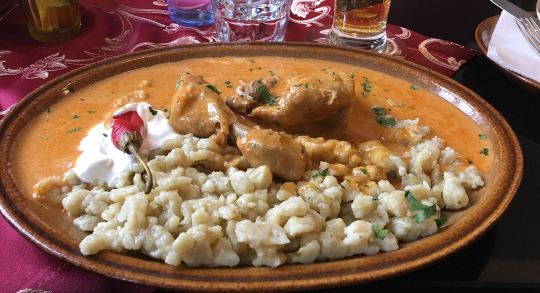
#dracula daily#dracula spoilers#long post#incredibly long post#let me know if i've missed any notable meals and i'll add them in#posted a day or two before the start of dracula daily so anyone wanting to eat along has time to get their shopping in
2K notes
·
View notes
Text
Why aren't ostriches kosher? A case-study for Kashrut laws
Unlike mammals and fish, the Torah does not provide a list of signs that identify a bird as kosher or non-kosher. Instead, it provides a list of non-kosher birds in Leviticus 11:13-19, and they are:
נֶּ֙שֶׁר֙- Eagle
פֶּ֔רֶס- Vulture (or Kite)
עׇזְנִיָּֽה- Black vulture (or Osprey)
דָּאָ֔ה- Kite (or Kestrel)
אַיָּ֖ה לְמִינָֽהּ- Falcon (or Vulture) of every variety
כׇּל־עֹרֵ֖ב לְמִינֽוֹ- All varieties of Raven
בַּ֣ת הַֽיַּעֲנָ֔ה- Ostrich
תַּחְמָ֖ס- Nighthawk (or Jay, or Goatsucker, or some species of Owl)
שָּׁ֑חַף- Gull (or Sparrow hawk)
נֵּ֖ץ לְמִינֵֽהוּ- Hawks of every variety
כּ֥וֹס- Little owl (or just Owl)
שָּׁלָ֖ךְ- Cormorant (or Gull)
יַּנְשֽׁוּף- Great owl
תִּנְשֶׁ֥מֶת- White owl
קָּאָ֖ת- Pelican (or Starling)
רָחָֽם- Bustard (or Magpie)
חֲסִידָ֔ה- Stork
אֲנָפָ֖ה לְמִינָ֑הּ- Herons of every variety
דּוּכִיפַ֖ת- Hoopoe
עֲטַלֵּֽף- Bat
The Torah repeats this list in Deuteronomy 14:11-18. As you can see, most of the species on this list are uncertain in translation (which is why I offered alternate translations), although you can see the general idea. But, we know 100% that ostrich is explicitly forbidden in the Torah, we don't even need to derive anything. The birds that are kosher are generally regarded as kosher based on unbroken tradition that they are (they are cases of birds no longer being considered kosher by most Jews despite them once being considered kosher, because the tradition was broken, but we'll get to that later).
Of course, there are many more birds species besides those listed, and very early on the Sages figured signs of kosher and non-kosher birds based on the list. First, as you can see, many of the birds on the list are birds of prey, so any birds of prey are automatically non-kosher. That was easy for them to figure out.
But what about anatomical signs?
Well, they figured that out, too. (Chullin 59a)
A bird that claws its prey and eats is non-kosher (such as birds of prey).
A kosher bird has a digit seperated slightler higher behind the other three toes, a crop, and/or a gizzard that has a membrane on the inside that can be peeled. Below is a comparison of raven feet and a parrot's foot, versus duck feet and chicken feet. On the left, the raven and parrot's feet have all their toes branching out of the same level. On the right, the duck and chicken feet's back toe is slightly elevated and seperate from the other toes.

A bird that perches on a wire with two toes in the front and two in the back is non-kosher, as demonstrated below by a close-up of a parrot's feet while perching. You can see that there are only two toes in the front, while the other two are in the back.
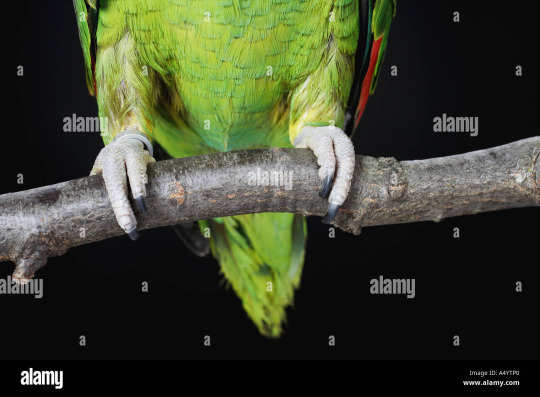
So, in order for a bird to be considered kosher, it must not be on the list of non-kosher birds provided in the Torah, must fulfil the anatomical descriptions outlined later by the Sages, and must have a tradition of being kosher.
Israel is the largest consumer of turkey meat per capita. This is because Jews eat a lot of turkey, including kosher-keeping Jews. But.....turkey is a New World bird! How can there be a tradition of turkeys being kosher if the ancient Israelites would have never encountered turkeys???
So this is where it gets even more interesting. When turkey was first introduced to Jews, it became widely popular. It's thought that Jews first started eating it because of its similarity to chicken, and assumed it must be kosher. Eventually, the Rabbis realized they had to make a decision about the status of turkeys. If they ruled turkeys as non-kosher, then all the Jews who had already been eating turkeys would be ruled as eating non-kosher, which y'know as a Rabbi you really don't want to declare a whole bunch of Jews as doing the wrong thing. So, most Rabbis relied on a passage in the Talmud stating that a non-kosher animal cannot become pregnant by kosher animals (Bekhorot 7a). Since turkeys and chickens can hybridize, Rabbis relied on this passage to declare turkeys as kosher. There are still some Jews today that don't regard turkey as kosher, but it is accepted as kosher by the majority of world Jewry and is a very popular meat.
What about peacocks? Well, peafowl are mentioned numerous times in the Tanakh and in Jewish history as being eaten, but today, the Orthodox Union does not certify them as kosher. Peafowl are genetically related to other kosher birds and have all the necessary signs.....but they are no longer considered kosher by major Orthodox opinions. This is because the last record of peafowl being considered kosher and eaten by a Jewish community was in the mid 19th century. The tradition was broken, and therefore peafowl aren't eaten or certified, despite the fact that they technically are kosher.
Now here's where is gets fun- somehow, the distinctions between kosher and non-kosher birds fit really neatly within our modern understanding of bird phylogeny. Most kosher birds fall under the Galliformes (chickens and friends) and Anseriformes (ducks and friends) Orders, which are more closely related to eachother than they are to any other Orders, and make up the Superoder Galloanserae. The only kosher birds that don't fall into that Superorder are pigeons and doves, but pigeons and doves are already considered a little different by the Sages- they're the only birds that can be used as offerings in the Temple. This is yet another example of how well the ancient Jewish animal classifications fit with out modern phylogenetic understanding, it's super cool. Because grebes and gallinules look a lot more similar to ducks than chickens do, but nope, they are not kosher while ducks and chickens are, and indeed, ducks and chickens are more closely related to each other than ducks are related to grebes and gallinules.
So, in conclusion- ostriches aren't kosher because
1) They are listed among the non-kosher birds in the Torah
2) They are missing toes- their toes are not in the configuration outlined in the Talmud, and in fact they only have two very large toes, as you can see below:

3) They do not have a crop (all ratites do not have crops)
Hope you enjoyed this long-winded way of answering why ostriches aren't kosher :)
Further Reading:
A Peafowl by any other Name
What Are the Signs of a Kosher Bird?
The Liberated Bird: Let’s Talk Turkey
195 notes
·
View notes
Text


Joining the fray. Co-operative hunting
White heron, little black cormorants and seagulls hunting in the Noosa River Mangroves.
#original photographers#wildlife photography#bird photography#white heron#little black cormorants#seagulls#noosa river#mangroves#co-operation#hunting
63 notes
·
View notes
Text
Inupiaq Books
This post was inspired by learning about and daydreaming about visiting Birchbark Books, a Native-owned bookstore in Minneapolis, so there will be some links to buy the books they have on this list.
Starting Things Off with Two Inupiaq Poets
Joan Naviyuk Kane, whose available collections include:
Hyperboreal
Black Milk Carbon
The Cormorant Hunter's Wife
She also wrote Dark Traffic, but this site doesn't seem to carry any copies
Dg Nanouk Okpik, whose available collections include
Blood Snow
Corpse Whale
Fictionalized Accounts of Historical Events
A Line of Driftwood: the Ada Blackjack Story by Diane Glancy, also available at Birchwood Books, is a fictionalized account of Ada Blackjack's experience surviving the explorers she was working with on Wrangel Island, based on historical records and Blackjack's own diary.
Goodbye, My Island by Rie Muñoz is a historical fiction aimed at younger readers with little knowledge of the Inupiat about a little girl living on King Island. Reads a lot like an American Girl book in case anyone wants to relive that nostalgia
Blessing's Bead by Debby Dahl Edwardson is a Young Adult historical fiction novel about hardships faced by two generations of girls in the same family, 70 years apart. One reviewer pointed out that the second part of the book, set in the 1980s, is written in Village English, so that might be a new experience for some of you
Photography
Menadelook: and Inupiaq Teacher's Photographs of Alaska Village Life, 1907-1932 edited by Eileen Norbert is, exactly as the title suggests, a collection of documentary photographs depicting village life in early 20th century Alaska.
Nuvuk, the Northernmost: Altered Land, Altered Lives in Barrow, Alaska by David James Inulak Lume is another collection of documentary photographs published in 2013, with a focus on the wildlife and negative effects of climate change
Guidebooks (i only found one specifically Inupiaq)
Plants That We Eat/Nauriat Niģiñaqtuat: from the Traditional Wisdom of Iñupiat Elders of Northwest Alaska by Anore Jones is a guide to Alaskan vegetation that in Inupiat have subsisted on for generations upon generations with info on how to identify them and how they were traditionally used.
Anthropology
Kuuvangmiut Subsistence: Traditional Eskimo Life in the Latter Twentieth Century by Douglas B. Anderson et al details traditional lifestyles and subsistance customs of the Kobuk River Inupiat
Life at the Swift Water Place: Northwest Alaska at the Threshold of European Contact by Douglas D. Anderson and Wanni W. Anderson: a multidisciplinary study of a specific Kobuk River group, the Amilgaqtau Yaagmiut, at the very beginning of European and Asian trade.
Upside Down: Seasons Among the Nunamiut by Margaret B. Blackman is a collection of essays reflecting on almost 20 years of anthropological fieldwork focused on the Nunamiut of Anuktuvuk Pass: the traditional culture and the adaption to new technology.
Nonfiction
Firecracker Boys: H-Bombs, Inupiat Eskimos, and the Roots of the Environmental Movement by Dan O'Neill is about Project Chariot. In an attempt to find peaceful uses of wartime technology, Edward Teller planned to drop six nukes on the Inupiaq village of Point Hope, officially to build a harbor but it can't be ignored that the US government wanted to know the effects radiation had on humans and animals. The scope is wider than the Inupiat people involved and their resistance to the project, but as it is no small part of this lesser discussed moment of history, it only feels right to include this
Fifty Miles From Tomorrow: a Memoir of Alaska and the Real People by William L. Iģģiaģruk Hensley is an autobiography following the author's tradition upbringing, pursuit of an education, and his part in the Alaska Native Settlement Claims Act, where he and other Alaska Native activists had to teach themselves United States Law to best lobby the government for land and financial compensation as reparations for colonization.
Sadie Bower Neakok: An Iñupiaq Woman by Margaret B. Blackman is a biography of the titular Sadie Bower Neakok, a beloved public figure of Utqiagvik, former Barrow. Neakok grew up one of ten children of an Inupiaq woman named Asianggataq, and the first white settler to live in Utqiagvik/Barrow, Charles Bower. She used the out-of-state college education she received to aid her community as a teacher, a wellfare worker, and advocate who won the right for Native languages to be used in court when defendants couldn't speak English, and more.
Folktales and Oral Histories
Folktales of the Riverine and Costal Iñupiat/Unipchallu Uqaqtuallu Kuungmiuñļu Taģiuģmiuñļu edited by Wanni W. Anderson and Ruth Tatqaviñ Sampson, transcribed by Angeline Ipiiļik Newlin and translated by Michael Qakiq Atorak is a collection of eleven Inupiaq folktales in English and the original Inupiaq.
The Dall Sheep Dinner Guest: Iñupiaq Narratives of Northwest Alaska by Wanni W. Anderson is a collection of Kobuk River Inupiaq folktales and oral histories collected from Inupiat storytellers and accompanied by Anderson's own essays explaining cultural context. Unlike the other two collections of traditional stories mentioned on this list, this one is only written in English.
Ugiuvangmiut Quliapyuit/King Island Tales: Eskimo Historu and Legends from Bering Strait compiled and edited by Lawrence D. Kaplan, collected by Gertrude Analoak, Margaret Seeganna, and Mary Alexander, and translated and transcribed by Gertrude Analoak and Margaret Seeganna is another collection of folktales and oral history. Focusing on the Ugiuvangmiut, this one also contains introductions to provide cultural context and stories written in both english and the original Inupiaq.
The Winter Walk by Loretta Outwater Cox is an oral history about a pregnant widow journeying home with her two children having to survive the harsh winter the entire way. This is often recommended with a similar book detailing Athabascan survival called Two Old Women.
Dictionaries and Language Books
Iñupiat Eskimo Dictionary by Donald H. Webster and Wilfred Zibell, with illustrations by Thelma A. Webster, is an older Inupiaq to English dictionary. It predates the standardization of Inupiaq spelling, uses some outdated and even offensive language that was considered correct at the time of its publication, and the free pdf provided by UAF seems to be missing some pages. In spite of this it is still a useful resource. The words are organized by subject matter rather than alphabetically, each entry indicating if it's specific to any one dialect, and the illustrations are quite charming.
Let's Learn Eskimo by Donald H. Webster with illustrations by Thelma A. Webster makes a great companion to the Iñupiat Eskimo Dictionary, going over grammar and sentence structure rather than translations. The tables of pronouns are especially helpful in my opinion.
Ilisaqativut.org also has some helpful tools and materials and recommendations for learning the Inupiat language with links to buy physical books, download free pdfs, and look through searchable online versions
132 notes
·
View notes
Text
The topics of Lucy's honesty, and how she presents her wellbeing in this letter are, but between these themes I just couldn't ignore Lucy's choice of bird, and what could mean despite only being a passing phrase in the entry.
"I have an appetite like a cormorant, am full of life, and sleep well."
One would think that Lucy, being someone who presents herself as the perfect arquetype of the young victorian lady would choose a more "delicate" bird to say how well she is. Yet, not only Lucy chooses to emphasize her eating habits (telling Mina that she is stout and healthy again), but also chooses a sea bird, the cormorant.
A seabird that mostly lives on shores, the "raven of the sea", one that works really hard to get their food as they plunge into the sea and dive every time the pangs of hunger start. A valued companion to fishermen for centuries. It is also a bird deemed "unclean" and therefore not good nor eating. So why does Lucy tells Mina that she has an appetite like a cormorant?
In england, and europe in general the cormorant has been associated with greed, and gluttony. A bird so greedy that steals the fish without looking behind from human fishermen before they could even throw their nets. Even in Jane Eyre this common bird is described as a greedy and rapacious creature. An all around symbol of bad omens, storms, and even death.
And Lucy takes all of this symbolism, turns it around, and tells to Mina that all of those qualities are good for her.
Yes, Lucy says it is good that she has an appetite like a cormorant. Yes she is being greedy with her food, and even indulging a little bit in gluttony. As the cormorant feeds itself with dozens of fish while their black plumage gets healthier and shinier; Lucy feeds without thinking of conduct while her cheeks return to their rosy state, and her body gets healthier and stout.
This bird may be associated with gluttony, but for Lucy this gluttony is a good thing. Cheers for her, and this small moment of selfishness!
#It's a tiny detail but now I love it#Also it's so funny how a bird is characterized as ''greedy'' for *checks notes* competing with humans for the fish and winning#dracula daily#dracula#lucy westenra
194 notes
·
View notes
Text
Sunday, February 11, 2024


Played "Abel Township Saga Season 10: How the Mighty Have Vision"
Runner’s Log:
ZRS10M25 (incomplete); 9:09 am; 73° at 87% humidity; 2 miles; 25:37; 12:47/mi. Morning run after morning mass. It’s cloudy and warm. Today’s run was kind of difficult and the whole time felt like I was running through sludge, but looking at my time really it’s on par with what I’ve been doing recently. I wasn’t really feeling it when I first went out and considered just walking instead but I’m glad I ran. Was only intending for 1.5 miles but when my ZR mission wasn’t finished, I thought I’d go until 2. Unfortunately, my ZR mission still isn’t finished :/ oh well (I wonder if it’s the zombie chases that are throwing off the time?). Evaded two zombie chases set to 12% (I lowered it from last time). I saw nine dogs on my walk today! There was one little black shih tzu who really wanted to kill me. Heard some birds chattering and saw some ducks, geese, cormorants, and egrets. I even did stretching on my balcony after the run.
121 notes
·
View notes
Text
72 notes
·
View notes